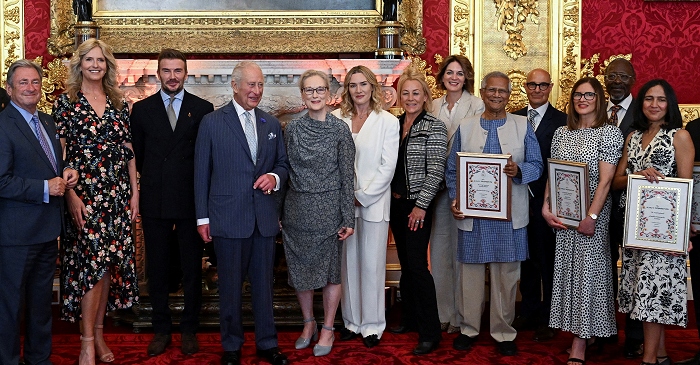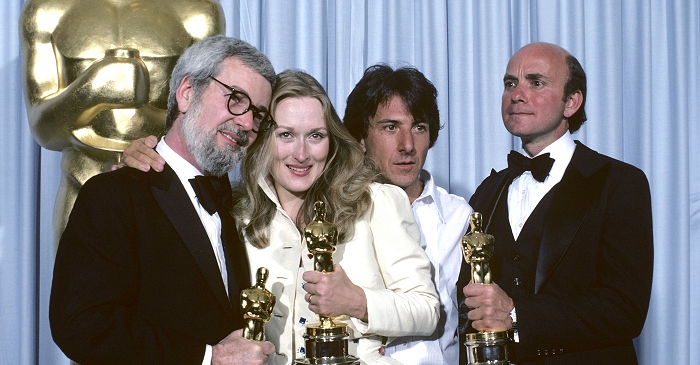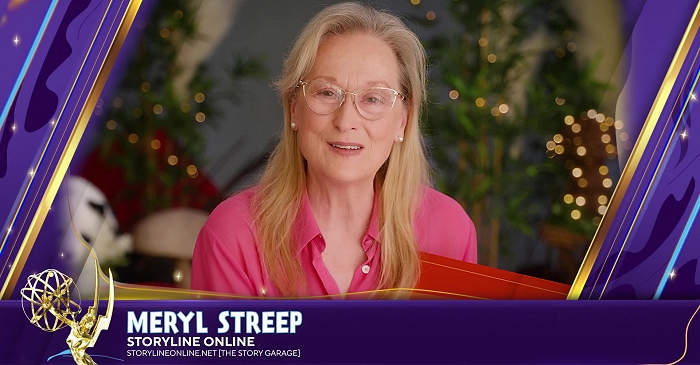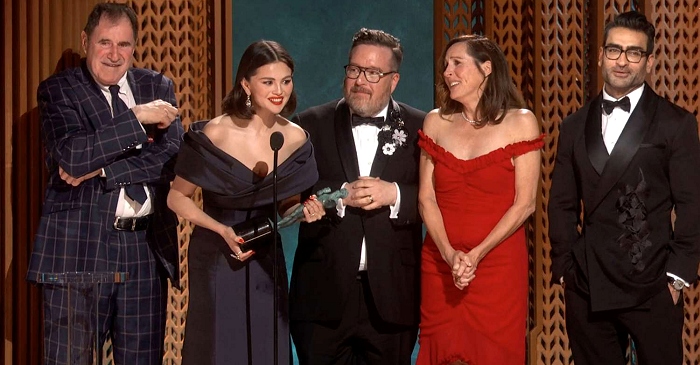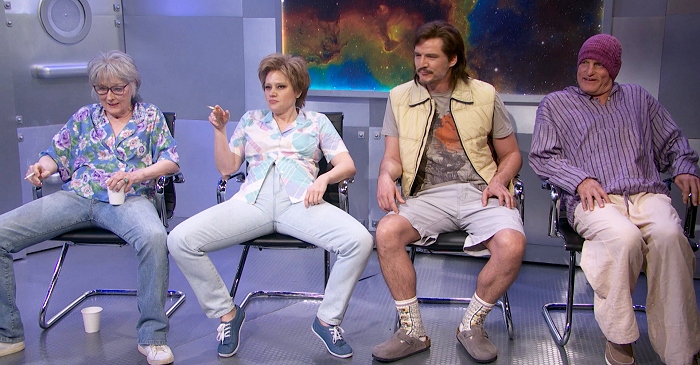|
Simply Streep is your premiere online resource on Meryl Streep's work on film, television and in the theatre - a career that has won her acclaim to be one of the world's greatest living actresses. Created in 1999, Simply Streep has built an extensive collection over the past 25 years to discover Miss Streep's body of work through thousands of photographs, articles and video clips. Enjoy your stay and check back soon.
|
|
Meryl Streep turns to funny page in career papered with drama
The Los Angeles Times ·
December 28, 1989
· Written by Nina J. Easton
|
“Did you see it?,” she asks, when the talk during a recent interview turns to tabloid reports about her relations with “She-Devil” co-star Roseanne Barr. “They put my head on Oprah Winfrey’s body,” she says, sitting back on her hotel room couch, letting the image sink in before breaking into peals of laughter. Maybe Streep has been suffering on-screen too long. She has the timing of a born comedian.
As the very blond, very coiffed Fisher, Streep has at last gone comic, even campy. She sweeps onto the screen in meticulous, lavishly pink designer garb, a biting caricature of today’s aerobicized, plasticized, anesthesized woman.
Portraying Fisher in a comic fairy tale about ugly-duckling revenge is only the beginning of the surprises in store from this 40-year-old, two-time Academy Award winner, the most respected actress of her generation. In next summer’s “Postcards from the Edge,” based on actress Carrie Fisher’s comedic book, Streep plays the wise-cracking, drug-addicted actress and daughter of an aging movie star. She also sings. Superficially, at least, she says “Postcards” provides the role closest to her–how she looks, talks and acts–of her career.
Streep has moved to Santa Monica temporarily because in February, she begins work on “Defending Your Life,” a courtroom comedy co-starring Albert Brooks, who will also direct.
Meanwhile, she has dropped plans to once again play a suffering character with a foreign accent–former Argentine ruler Evita Peron.
“It was a bitter disappointment,” says Streep. “But it’s just a movie. As Albert (Brooks) said, ‘You know, Meryl, you could do this and it would be the toughest thing you’ve ever done in your life. It would be monumental. It would be fantastic. It would be huge. And everyone would say, So what?’ ” Streep’s voice slips into a snide nasal tone. “ ‘What else is new?’
“That’s the joke about me, that I do all these really hard roles,” Streep says, with no trace of bitterness in her voice. Her career may be short on on-screen punchlines, but off-screen she laughs at herself and wryly comments on the world around her. “I guess they’re sick of me,” she says of her detractors, and again she laughs.
The great irony of Streep’s career is that she has transformed herself, chameleon-like, into such a diverse range of characters that by now these Oscar-attracting performances seem almost routine. She insists that comments from critics like Kael “mean nothing.” But she also suggests she feels some impact. “It’s out there in the air, like smog,” she says of the criticism. “You don’t feel smog going into your lungs. If the day’s beautiful, you don’t notice.”
Whether her motives come from an inner drive, or are the result of the air quality around her, Streep–for now at least–is adding a new chapter to her career. She has turned the page on Lindy Chamberlain, the persecuted Australian mother in “Cry in the Dark”; on Helen, the ragged transient in “Ironweed”; on the death camp survivor Sophie in “Sophie’s Choice”; on Baroness Karen Blixen in “Out of Africa”; on Joanna Kramer, the conflicted mother in “Kramer v. Kramer.”
Mary Fisher has arrived.
It may be difficult to envision Mary Fisher as a role that Meryl Streep was born to play, but she has been preparing for it most of her life–at least since the first blonde vixens crossed her path in junior high. Streep herself wasn’t immune to the demands of the beauty machine, though she may have approached it with a hint more irony than her peers. The daughter of a commercial artist (her mother) and a pharmaceutical company executive, Streep the teen-ager pulled out the bottle of peroxide and put in a pair of contacts to transform herself into a knock-out cheerleader at her suburban New Jersey high school.
By the time the role of Mary Fisher was offered two decades later, Streep was more than ready. “Ohhhh,” she growls, “I just wanted to get it all in.” She surprised “She-Devil” director Susan Seidelman by showing up at an early reading dressed for the part.
“She came into the room as Mary Fisher, with the perfectly coiffed nails and her hair all bouffanted,” Seidelman recalls.
“The character could have gone a lot of ways,” Streep says of Mary Fisher. “But I wanted to (deal with) traditional notions of beauty. I thought I was making fun of that. But I must say, the crew treated me real nice when I had my Mary outfit on, and my fingernails were all false and pasted on, and I had on all this sloppy jewelry, and my hair teased up and fluffed, and the makeup was on like lacquer. Barbie,” she adds firmly, “is never going to go out of style.”
As she says this, Streep sits in a hotel room on the Westside of L.A.–a hub of pre-fab beauty, where liposuction is fast becoming as popular as the convertible and teen-age visits to the plastic surgeon are estimated to be up threefold in the 1980s. It is a far cry from Streep’s more frumpy life style in rural Connecticut, where she plays housewife to sculptor husband Don Gummer and cares for her three children when she’s not on a distant movie set.
But there are Mary Fishers everywhere, even in rural Connecticut. The one she plays in “She-Devil” lives in a pink palace on Long Island, where she spends one part of her time writing trashy romance novels, and two parts of her time remaking herself into a male fantasy of the ideal woman. The movie focuses on Barr’s single-minded plan for revenge after the romance novelist steals her accountant husband, played by Ed Begley Jr.
Streep notes that the film is not only commenting on “how Mary looks. It’s the time she spends looking like that. It’s horrifying how much time we all spend on that. I’m not anti-pink. It’s just that offering-of-the-neck version of feminity that I find so loathsome. It’s hard for me to say this, because I’m sure it’s important to a lot of women, but I don’t like it when people design themselves, like when women use different voices with men (than with women).”
Seidelman and producer Jonathan Brett couldn’t help flinching when they saw Fisher look-alikes show up at screenings of “She-Devil.” But Seidelman says she doesn’t expect Streep’s comic portrayal to offend too many women. Like the Fay Weldon novel on which it is based, says Seidelman, the characters in “She-Devil” are exaggerations of real-life figures, the story a fairy tale.
“We didn’t want to attack anyone,” Seidelman says. “By exaggerating (the character) a little, maybe even these women can see themselves as victims.” Even the beautiful Mary Fisher considers plastic surgery when the philandering Begley starts “working late.”
Perhaps not surprisingly, given her affinity for challenging parts, Streep first toyed with the idea of playing the homely Ruth Patchett in the film. Seidelman was relieved that Streep instead opted for the role of Mary Fisher. “Even though Roseanne is not as experienced an actor, it would have been less effective if a glamorous woman was frumping it up,” the director says.
Streep became intimate with her character during years of working in an industry that has always placed a premium on good looks, particularly for women. “There’s no doubt that when beautiful women come on the screen, it’s breathtaking, because the image is so huge,” she says. “There’s a moment in a woman’s life that has this matchless affect in the way she appears on screen. It’s magic for women, as well as men, to look at. And (these actresses) don’t have to have to be able to string two words together, never mind about their character development or their analysis of the script.
“There’s nothing wrong (with Hollywood’s appreciation of beauty),” Streep adds, “unless there are no other women in the movies.”
Despite those prominent cheekbones and an angular nose that have come to be appreciated as her own unique brand of beauty, Streep has demonstrated an eagerness to play those less-than-glamorous “other women.”
“I don’t want to ride a polemic here,” she says, “but I do like people to see the beauty in the soul. That’s why I take certain roles like (Helen) in ‘Ironweed’ and Lindy Chamberlain (in ‘A Cry in the Dark’).”
The double standard for men and women in Hollywood extends beyond looks. Despite her many Oscar nominations and critical standing, Streep is vastly underpaid compared to the fees being earned by top male stars. Recent studies have shown that the male-female pay gap is greater in the artistic professions than in other sectors of the economy.
“I try (for higher salary demands) because if I undercut myself I don’t do anybody a favor who has not achieved as much,” Streep says. But, she notes, it’s not easy. “As it is, I make half what Dustin (Hoffman) makes, half what (Robert) Redford makes, half what Jack (Nicholson) makes,” she says. “I don’t begrudge them what they make, because they’re smart. But I do think that’s amazing.”
Streep has starred in a handful of hit films, including “Silkwood,” “Sophie’s Choice” and “Out of Africa,” but a number of her recent movies fell flat at the box office, including “Cry in the Dark,” “Ironweed,” and “Heartburn.” But Streep says that’s no excuse for the differential in salaries between her and someone like Nicholson, who was paid $11 million to star as the Joker in “Batman.”
“I was in movies with Jack (‘Ironweed,’ ‘Heartburn’) that no one came to see. So if he’s such a fabulous draw . . . “ she says, her voice trailing off.
A salary dispute was one reason for Streep’s withdrawal from “Evita” last fall, after preparing for the role for more than a year. Ironically, she pulled out when her escalating salary demands were finally met. By then, the project–spearheaded by producer Robert Stigwood and to be directed by Oliver Stone–had been dropped from Weintraub Entertainment Group’s slate and had moved to Carolco.
“Originally, they were complaining that they just simply didn’t have the money,” says Streep. “I wanted to do the part so badly that I went to the altar (and accepted a salary cut). Then (Carolco) came in and I said I would like to be paid what I usually get paid and suddenly the money was there. “So,” she adds, laughing, “I actually got insulted that the money they were saying they didn’t have for a year and a half was suddenly available . . . I can work very, very hard, but not when I feel I’m being lied to, or that I mistrust the circumstances.”
A few weeks after dropping out, she indicated that she might reconsider the decision. Now, however, with Oliver Stone also off the project, she doesn’t see “Evita” in her future.
Actually, she adds, the decision to drop off the project involved reasons other than salary. She says she felt drained by the interminable negotiations and difficulties in getting the big-budget picture off the ground.
“I had fallen out of love with the project,” she says. “The joy had been stripped from it. It was like Sisyphus, pushing a boulder up a hill.” Streep’s remarks echo similar published comments made earlier by Stone.
Though various producers have been trying to get a film version of the stage musical “Evita” off the ground for 10 years, Stone and Streep came onto the project in the spring of 1988. Streep began undertaking intensive training in singing and dancing.
“I thought it was going to be an exciting film, the way Oliver had conceived it,” she says. “It was very gritty. It was a story about how people transform themselves and design themselves–not only into something they convince themselves of, but into something convincing to whole masses of people. I just had a good feeling about Oliver; he had put together a visually stunning piece.”
Original plans called for the film, with a $29 million budget, to be shot in Argentina. But, reacting to concerns about unrest in that country, Weintraub moved production planning to Spain, where the budget escalated to $35 million. Last summer, Weintraub–by then a company in the midst of serious financial problems–dropped the project. Streep then dropped out, followed by Stone.
Despite her intensive preparation for the role, characters like Evita come fairly easily to Streep. She says she readily picks up foreign accents. “ It’s a very mechanical thing, a musical thing. My son, for example, can remember tunes with ease, but my daughter doesn’t do that.”
A graduate of the Yale School of Drama, Streep describes her training in acting as a patchwork of ideas and styles, and claims to know nothing about “Method” acting, the live-your-character course that the late Lee Strasberg taught to such students as Marlon Brando, James Dean and Paul Newman at the Actors Studio in New York. “I don’t know what the Method is,” she says. “I’ve never read the book and I didn’t learn it in school. I have sort of a hodge-podge education–which was something to complain about in drama school, but it turned out to be very valuable. You get a little bit of everybody’s ideas.
“I don’t really prepare all that much,” she adds. “It’s more instinctual than that. It all comes down to the same thing; just locating a truth within yourself.”
Streep says she has found most of her roles exhilarating rather than frustrating or exhausting. Her most difficult part, she says, was in Robert Benton’s critically panned “In the Still of the Night,” a Hitchcockian thriller in which she co-starred with Roy Scheider. “The character was a cipher,” she says. “All I had to do was look good, and it was impossible to look good because there was no inner beauty. It was all about doing her hair, getting the lighting right.”
Streep may turn plenty of heads in her upcoming comedic roles. But, as she notes, many of the parts she played in drama school–characters created by playwrights like Christopher Durang–drew plenty of laughs. “I always did very comical roles when I went to school,” she says. “In drama school, there was an exhortation to make the outrageous choice. That was the credo.”
It was her face, she says, that shaped her direction on film.
“I have a kind of serious nose, and a serious face,” she says. “Early on, my physiognomy sort of dictated what I would be cast as in films. I’ve been looking for a script that made me laugh. I go to a lot of movies where people are all laughing around me and I feel like I’m from outerspace because I find it dangerous and stupid and horrible and degrading to women and all these things.”
The script for “She-Devil,” she said, made her laugh. And, she adds, the characters had an imperative, their stories needed to be told.
Now all she has to do is convince the Pauline Kaels of the world that Meryl Streep can giggle with the best of them.






